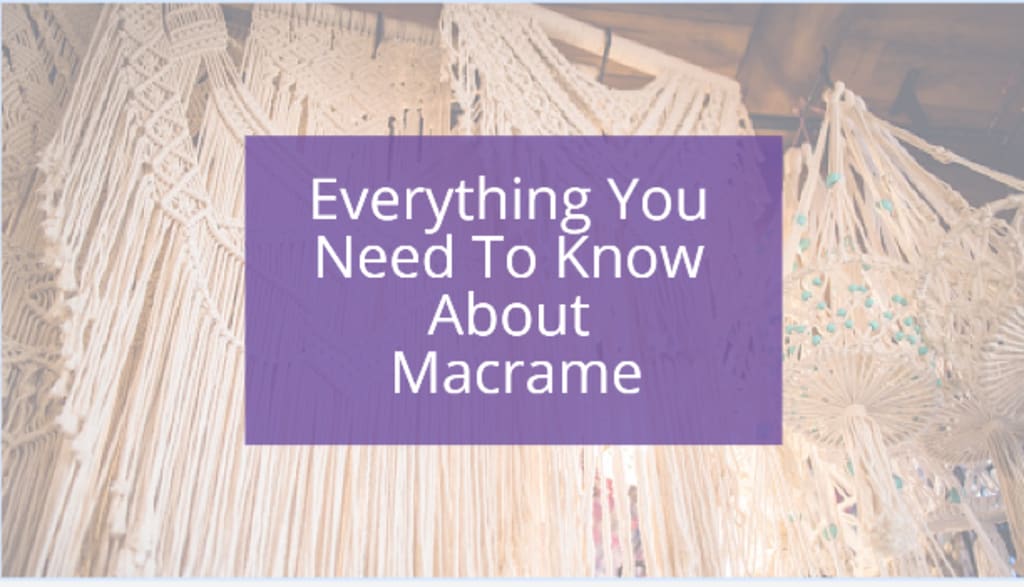
Knotting—or macramé—is one of many crafts being revived by those who love working with their hands. Just like surface embroidery, quilting, and needlework are seeing a bump in popularity, macramé is being transformed from a 1970s relic into a hot, trendy art form.
A versatile form of fiber art, macramé can be used to make everything from wall hangings and plant hangers to jewelry, purses, and even clothing items. Using simple materials like cotton twine, jute, hemp, or yarn, macramé can be as simple or complex as the crafter would like. Embellishments like glass or wooden beads, as well as dyed threads, can also open up a range of creative possibilities.
Learn a little more about the fascinating history of macramé before diving into basic techniques and advice on how to start making your own or purchasing some contemporary macramé.

The History of Macramé
Macramé’s roots are actually quite interesting, with a history dating back thousands of years. Some believe that the term comes from the 13th-century Arabic word migramah, which means “fringe.” Others believe its origins lie in the Turkish word makrama, which refers to “napkin” or “towel,” and was a way to secure pieces of weaving by using excess threads along the top or bottom of woven fabrics.
Related: Fun Gifts For People Who Are Crazy Over Macrame
Either way, decorative macramé actually first appears in carvings by the Babylonians and Assyrians that depict fringed braiding used to adorn costumes. In the 13th century, Arab weavers used decorative knots to finish the excess thread on shawls, veils, and towels. It then spread to Europe via North Africa, when the Moors brought macramé to Spain.
While most think of macramé as a craze of the 1970s, the craft reached peak popularity in Victorian England. First introduced to England in the late 17th century, Queen Mary herself taught classes to her ladies-in-waiting. Most Victorian homes had some type of macramé decoration, as it was used not only to decorate clothing, but also as curtains, tablecloths, and bedspreads.

Given their skill at making knots, it should come as no surprise that sailors are largely responsible for spreading macramé around the world. It was a great way to pass the time and could then be bartered or sold when they docked, thus bringing it to areas like China and the New World. Hammocks, belts, and bell fringes were some of the popular items made by British and American sailors in the 19th century. Texts like 1877’s The Imperial Macramé Lace Book, which goes into detail about different knots and patterns, show just how popular the technique was at the time.
After fading in popularity, macramé saw a resurgence in the 1970s. It came to symbolize the Bohemian style and was used to make wall hangings, plant hangers, accessories, and clothing. The craft eventually waned in popularity, but trends tend to be quite cyclical. Now, macramé is back, making waves again as creative crafters come up with contemporary patterns that have revitalized the historic knotting techniques.
What is Macrame

Macramé Supplies and Resources
There are a wide variety of natural and synthetic fibers you can use to create macramé. Standard projects will typically require cords that are 3 mm to 6 mm thick. Jewelry and small decorative items are created through micro-macramé, which simply means that the cord used is 0.5 mm to 2 mm thick.
Free Macramé Patterns – This comprehensive website should be your first stop for all things macramé. Not only are there free patterns, but there are many articles for beginners, a dictionary of common terms, and even a section on macramé for kids. Through their Etsy shop you can find all types of colored cords, vintage pattern books, beads, and much more.
Modern Macramé – You’ll find a beautiful array of colored cotton rope, as well as DIY kits, and tutorials. You’ll also want to check out founder Emily Katz’s book Modern Macramé: 33 Stylish Projects for Your Handmade Home for inspiration.
Pepperell Braiding Company – Started in 1917 as a factory to produce shoelaces, today Pepperell is a well-known manufacturer of macramé cords and supplies. You’ll find everything from wood beads and dowels to a variety of cords and DIY kits.
Read more about the art of macrame
About the Creator
Dandelionclub
Writer, Hobbyist, Traveller, Art Lover





Comments
There are no comments for this story
Be the first to respond and start the conversation.